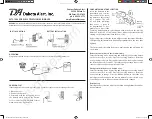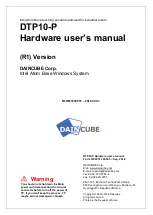
8
Commissioning
Warning
• Keep hands away from moving parts (see section 6).
During commissioning, you need to define the positions of the actuator and/or
process valve in which the sensor box is to return the desired signals (end
position 1, end position 2, and mid-position if applicable). This is done by moving
the rotating reed switch holders on the shaft (Fig. 1
6
) into the desired position.
When the fixing screw is loosened, all reed switch holders can be moved manually
with e.g. a pin. The reed switch holders for the end positions can also position
themselves automatically with the aid of the driver.
1
Reed switch holder,
mid-position (optional)
2
Fixing screw
3
Reed switch holder, end
position 2
4
Magnet holder with holes for
driver
– Hole a for end position 1.
– Hole b for end position 2.
5
Circular scale; 5° graduation
6
Reed switch holder, end
position 1
Fig. 12
2
3
4
5
1
a
b
6
Manually adjusting the reed switch holders
1. Loosen the fixing screw (Fig. 12
2
or Fig. 13
1
) by unscrewing it ¼ to ½ turn –
do not
unscrew it all the way out!
2. Carefully move the reed switch holders (Fig. 12
1
,
3
,
6
) into the desired
position using e.g. a pin.
3. Now, check the signalling response of the sensor box in a test run. When a reed
switch is actuated, the corresponding LED lights up (see Fig. 1
7
). If an error
was made, repeat point 2.
4. Finally, re-tighten the fixing screw till finger-tight.
Automatically positioning the reed switch holders for the end positions
In clockwise operation, the reed switch holder for end position 1 is usually brought
into the desired position first; in anti-clockwise operation, the reed switch holder
for end position 2 is brought into position first. Fig. 13 shows an example of how
the driver in hole a moves the reed switch holder for end position 1during a clock-
wise rotation:
3
1 is the starting position and
3
2 is the final position.
1
Fixing screw
2
Reed switch holder, end
position 2
3
Magnet holder
1: starting position
(example)
2: final position (example)
4
Reed switch holder, end
position 1
5
Driver in hole a
6
Reed switch holder,
mid-position (optional) –
here outside the angle of
rotation
Fig. 13
2
3
4
1
6
5
1
2
3
1. Loosen the fixing screw (Fig. 13
1
) by unscrewing it ¼ to ½ turn –
do not
un-
screw it all the way out!
2. With SRBP-...-A-: move the reed switch holder for mid-position outside of the
angle of rotation (see Fig. 13
6
). The driver (see Fig. 13
5
) is only used for
moving the reed switch holders for end positions.
3. Align the reed switch holders for the end positions so that they can be picked up
by the driver during rotation when the driver is in the corresponding hole (see
Fig. 12
4
a or b).
4. To set end position 1 (clockwise rotation):
a) Insert the driver into hole a (see Fig. 12
4
).
b) Move the actuator into end position 1.
5. To set end position 2 (anti-clockwise rotation):
a) Insert the driver into hole b (see Fig. 12
4
).
b) Move the actuator into end position 2.
6. Pull the driver back out of the hole.
7. With SRBP-...-A-: carefully move the reed switch holder for mid-position into the
desired position by hand – using e.g. a pin.
8. Now, check the signalling response of the sensor box in a test run. When a reed
switch is actuated, the corresponding LED lights up (see Fig. 1
7
). If an error
was made, repeat points 2. to 8.
9. Finally, re-tighten the fixing screw till finger-tight.
At the end of commissioning
• Mount the cover on the sensor box – torque 5 Nm.
9
Operation
• Compare the maximum values specified in these operating instructions with
your actual application (e.g. pressures, forces, torques, masses, speeds, tem-
peratures). The product can only be used in accordance with the relevant safety
guidelines if the maximum load limits are observed.
10
Service and maintenance
If used as designated in the operating instructions, the device will be free of
maintenance.
• Clean the outside of the product with a soft cloth. The permitted cleaning agent
is soap suds.
11
Removal and repairs
Make sure that the following energy sources are switched off:
– Electrical power supply
– Compressed air supply
• Remove the sensor box in the reverse order of installation
(
section 7.1).
For information about spare parts and auxiliary means
www.festo.com/spare-
parts.
12
Eliminating malfunctions
Malfunc-
tion
Possible cause
Remedy
Incorrect or
unexpected
signal
Broken wire
Replace cable
Position of the switching points incorrectly
defined
Correct the position of the swit-
ching points
Fig. 14
13
Technical data
SRBP-...-...
...-20N
...-1U
Based on standard
VDI/VDE 3845 (NAMUR)
Mounting position
Any
Protection against short circuit
No
Measured variable
Rotation angle
Measuring principle
Magnetic reed
Reverse polarity protection
For operating voltage
Setting range, angle sensing
[°]
0 ... 270
1)
Sensing range tolerance
[°]
Min. -5/max. +5
Setting range of switching elements
With built-in overtwist protection
Switch-on time
[ms]
< 10
Switch-off time
[ms]
< 10
Interference immunity
See declaration of conformity
www.festo.com
Interference emission
CE mark (see declaration of conformity
www.festo.com)
In accordance with EU EMC Directive
2)
Continuous shock resistance to DIN/IEC 68, part 2-82
Shock resistance to DIN/IEC 68, part 2-27
Vibration resistance to DIN/IEC 68, part 2-6
– When directly mounted on DFPB-...
Severity level 2
– When mounted with mounting bracket
Severity level 1
Protection class
IP65
Ambient temperature
[°]
–20 ... +80
Surge capacity
[kV]
0.8
Insulation voltage
[V]
50
Degree of contamination
3
Operating voltage range DC
[V DC]
7.8 ... 8.6
19.2 ... 28.8
Operating voltage range AC (50 … 60 Hz)
[V AC]
–
19.2 ... 28.8
Max. output current per output
[mA]
I
OFF
≤ 1
I
ON
2.5 … 10
500
Max. contact rating per output
– With AC voltage
[VA]
–
10
– With DC voltage
[W]
–
10
Overload protection
No
Idle current
[mA]
≤ 1
0 ... 10
3)
Hysteresis (against direction of rotation)
[°]
3 ... 6
Repetition accuracy of switching point
[°]
± 1
Switching travel (rotation towards end po-
sition)
[°]
≥15
Switching travel (rotation towards mid-po-
sition)
[°]
≥15; ≤ 38
Temperature coefficient of switching point
[°/K]
0.02
Materials information
4)
– Housing, shaft
Wrought aluminium alloy
– Cover of position indicator
Polycarbonate
– Seals
Nitrile rubber, fluoro elastomer
– Mounting screws, toothed disc, retaining washer
Stainless steel (A2-70)
– Sensor system, position indicator (internal)
Polyacetate
1)
In the end positions, the switching signal is set about 20° before the end position is reached.
2)
In residential areas, measures for radio interference suppression may be necessary.
3)
LED current in total < 10 mA
4)
For information on the resistance of materials to aggressive media
www.festo.com.
Fig. 15









































